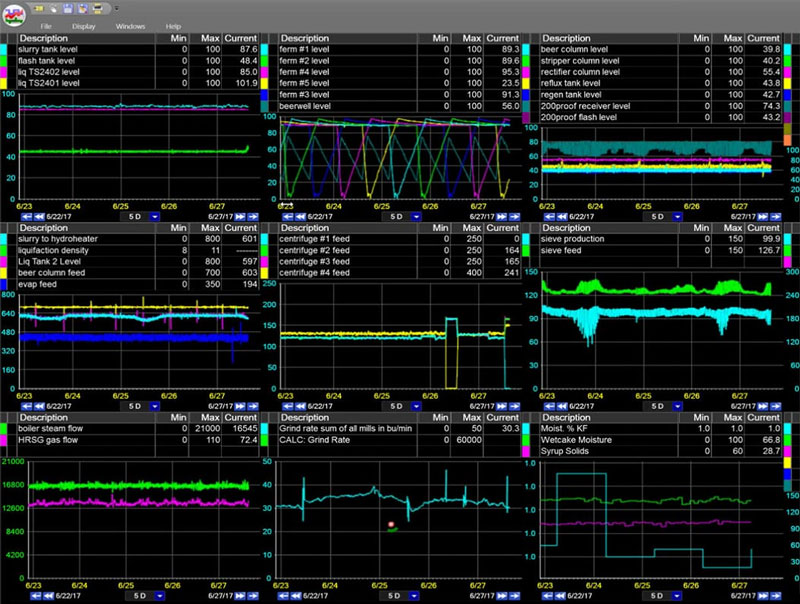In this blog, discover how OEE data collection software can significantly boost efficiency, minimize waste, and enhance productivity in manufacturing. Learn why OEE monitoring is essential for your processes and how implementing a software solution can reduce downtime and optimize machine performance. Start transforming your operations today.
Why Your Manufacturing Operation Needs OEE Monitoring
OEE stands for Overall Equipment Effectiveness. It is the standard across industries for for evaluating machine efficiency. OEE offers a comprehensive view of equipment performance through availability, performance, and quality.
Since a calculated OEE score incorporates these three variables, it can help identify specific production inefficiencies. Whether due to downtime, speed losses, or quality defects—allowing for targeted improvements that enhance productivity and reduce waste.
Using an OEE data collection software facilitates real-time tracking and analysis, enabling instant responses to operational issues. This can prevent minor inefficiencies from becoming costly problems.
What is OEE Data Collection Software?
OEE data collection software was designed to solve the challenge of automating and centralizing the calculation of OEE data across manufacturing operations. Traditionally, the components of OEE—availability, performance, and quality—were monitored separately, leading to data silos. This segmentation made it difficult for manufacturers to get a comprehensive view of equipment and pinpoint inefficiencies’ root causes.
OEE data collection software integrates these diverse data streams into a single, cohesive platform. This integration allows for real-time monitoring and calculation of OEE, providing manufacturers with an immediate view of their production efficiency.
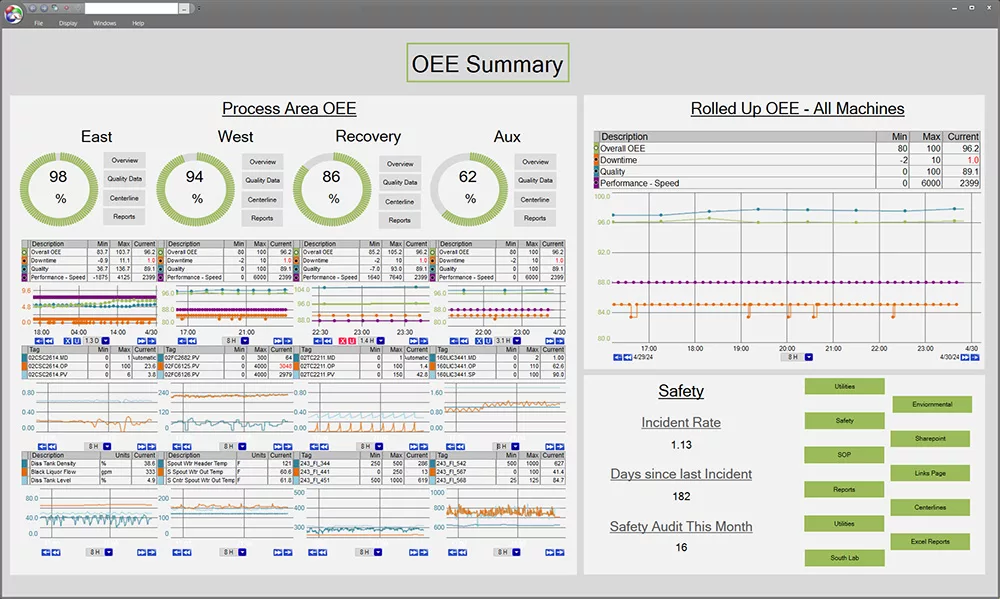
This OEE summary graphic is a prime example of how OEE tracking software collects, monitors, and assists in troubleshooting to optimize operational efficiency.
More importantly, the software enables users to view the OEE score and dive further into the underlying production data. By breaking down the OEE into its parts, manufacturers can identify specific areas—be it machine downtimes, speed losses due to minor stoppages, or defects affecting product quality.
This capability of drilling down helps manufacturers understand the “why” behind the OEE scores, facilitating targeted actions to improve specific aspects of their operations. Furthermore, having all the OEE-related data in one place simplifies the process of tracking progress over time, evaluating the impact of changes made, and continuously refining processes to enhance productivity.
In essence, OEE software is more than a tool for calculation; it’s a comprehensive solution that empowers manufacturers to optimize their equipment usage, streamline their processes, and ultimately boost their bottom line.
What Does OEE Software Do?
OEE software is a powerful tool designed to enhance the efficiency and productivity of manufacturing operations. Here’s a breakdown of the core functions that OEE software performs:
Automate OEE Data Collection
OEE software should automate data collection required to calculate the three critical components: availability, performance, and quality. By automating data collection, the software eliminates manual entry errors and frees up personnel to focus on higher-value tasks. Automation ensures that data is collected consistently and accurately, providing a reliable basis for OEE calculations.
Diagnose Production Efficiency
One of the primary functions of OEE software is to diagnose the efficiency of production processes. It analyzes collected data to provide a detailed breakdown of where potential losses are occurring and why. This diagnostic capability enables manufacturers to pinpoint specific areas for improvement, whether in machine operations, workflow inefficiencies, or quality control processes.
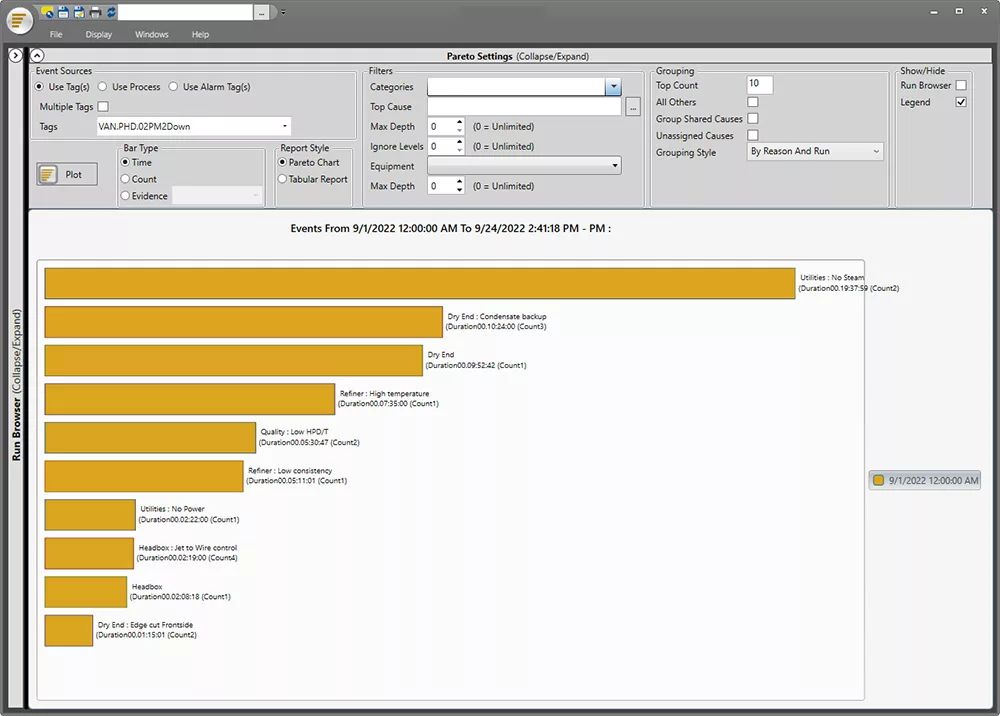
Utilize OEE software for effective production loss tracking, pinpointing major inefficiencies, in this Pareto steam loss is easily pointed out as an issue.
Monitor Shifts and Line Efficiency
Depending on the frequency of the OEE calculation, the software might also track the efficiency of different shifts or compare production lines. This monitoring helps managers and operators identify patterns of efficiency across different times and conditions, leading to more informed decision-making about staffing, machine use, and operational scheduling.
Monitor Equipment Performance
Monitoring equipment performance is another critical function of OEE software. It provides real-time insights into how machines are performing against expected benchmarks. This ongoing monitoring helps catch issues before they lead to significant downtime or quality issues, allowing for proactive maintenance and adjustments.
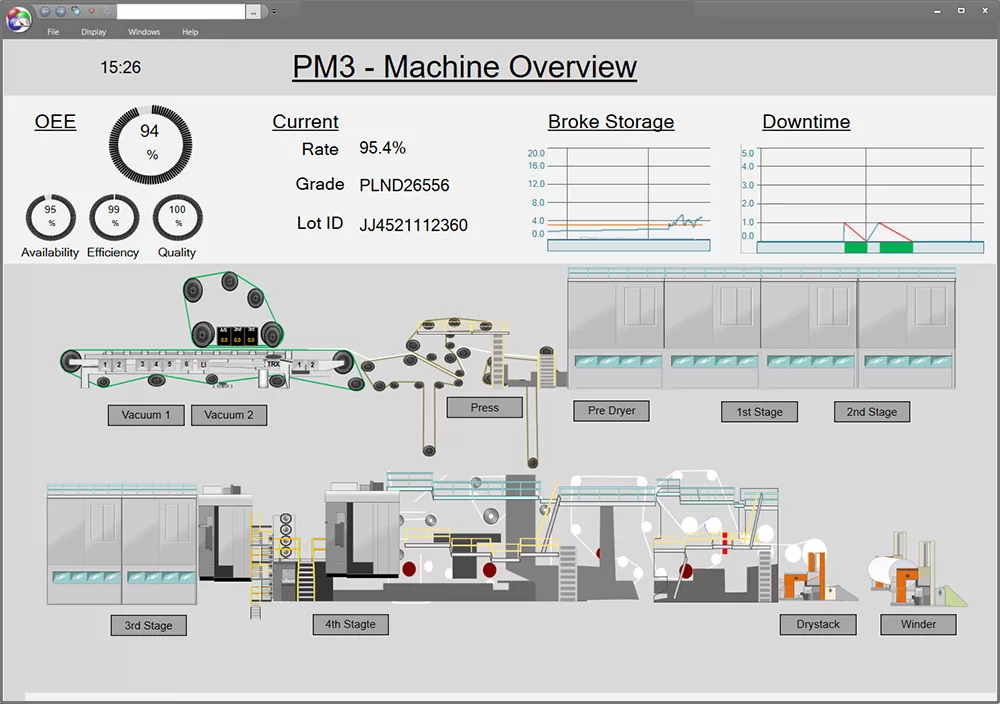
This simplified dashboard displays OEE data alongside machine information. It exemplifies how monitoring equipment performance through OEE software can enhance operational insights and drive efficiency.
Discover Underperforming Machines
Finally, OEE software is instrumental in discovering underperforming machines within the manufacturing process. It highlights equipment that consistently fails to meet performance standards, which can then be targeted for maintenance, upgrades, or optimization. Identifying these machines helps prevent potential bottlenecks in the production process and improves overall operational efficiency.
By performing these functions, OEE software not only boosts operational efficiency but also supports continuous improvement initiatives within manufacturing environments, leading to sustained increases in productivity and profitability.
Benefits of Overall Equipment Effectiveness Tracking
OEE tracking is a pivotal tool for manufacturing operations, providing numerous benefits that lead to more efficient and profitable production processes. Here’s how OEE tracking can transform your manufacturing operations:

Achieving Environmental Excellence: Your guide to environmental KPIs, strategic practices, and more!
Help Improve ROI
Implementing OEE tracking helps improve return on investment by enhancing the efficiency and effectiveness of production equipment. By identifying and minimizing inefficiencies, companies can produce more high-quality products in less time with the same amount of resources. This increased productivity translates directly into better returns, as more products can be sold without a corresponding increase in production costs.
Reduce Costs
OEE tracking plays a crucial role in cost reduction. Manufacturers can implement targeted improvements by pinpointing specific areas where production losses occur, such as machine downtime, slow cycles, or quality defects. Reducing downtime and waste directly cuts costs associated with wasted materials and inefficient labor use while extending the machinery’s lifespan through better maintenance practices.
Allows for Dynamic Problem Solving
With real-time data at their fingertips, operators and managers can solve problems dynamically as they occur. OEE software provides immediate insights into issues that may disrupt production, enabling quick responses that prevent minor issues from escalating into costlier problems. This capability to respond swiftly and effectively reduces downtime and ensures that production targets are consistently met.
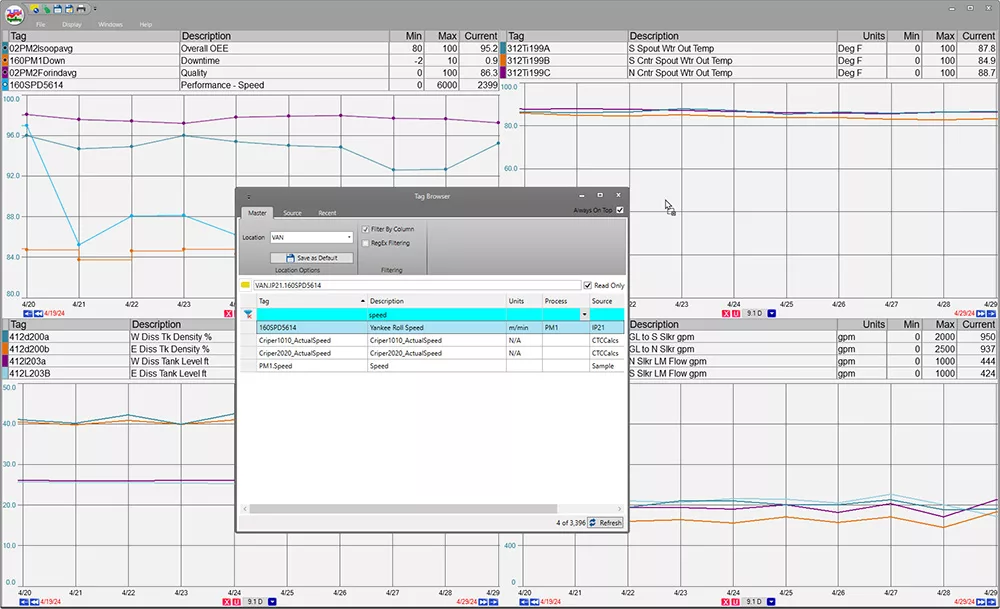
PARCview allows users can effortlessly drag additional process data into trends. With the OEE tags already there, process data enables comprehensive troubleshooting and immediate insights for efficient problem-solving.
Data to Streamline Production Processes
OEE tracking supplies a wealth of data that can be used to streamline production processes. By analyzing this data, manufacturers can identify bottlenecks, unnecessary complexities, and opportunities for process optimization. Streamlining these processes increases production speed and efficiency and improves product consistency and quality.
Monitor Key Performance Indicators
OEE tracking allows manufacturers to continuously monitor key performance indicators (KPIs) such as machine availability, performance speed, and quality rates. Keeping a close eye on these KPIs helps manufacturers maintain high production standards and quickly address deviations from these standards. Regular monitoring also supports strategic planning by clearly showing production trends and outcomes.
Enhance Equipment Utilization
OEE software optimizes equipment utilization by monitoring real-time performance and identifying underperforming assets. This allows for targeted maintenance and adjustments that improve machinery efficiency and extend its lifespan. By minimizing unplanned downtime and maximizing machine availability, OEE software ensures that equipment operates at its peak, contributing to smoother production flows and increased output. This strategic approach boosts productivity and reduces maintenance costs over time.
Increase Operational Transparency
OEE software can enhance a site’s operational transparency. By collecting and visualizing data OEE software provides both management and floor operators with a clear, unambiguous view of production realities. This level of transparency ensures that all stakeholders have access to the same information, fostering a more cohesive decision-making process. It also enables quick identification of bottlenecks and inefficiencies, allowing for prompt and informed responses. Ultimately, this comprehensive visibility helps align strategic decisions with actual production conditions, optimizing resource allocation and improving overall operational effectiveness.
Why Continuous Improvement is Essential in Manufacturing Operations
Manufacturing operations must continuously evolve to meet changing market demands, technological advancements, and competitive pressures. This ongoing adaptation ensures that operations can effectively seize opportunities and mitigate risks.
OEE software plays a crucial role in this dynamic environment. It provides detailed insights into production inefficiencies, enabling targeted improvements that maximize output while minimizing resource wastage. This approach helps reduce costs, increase profitability, and support a culture of continuous improvement.
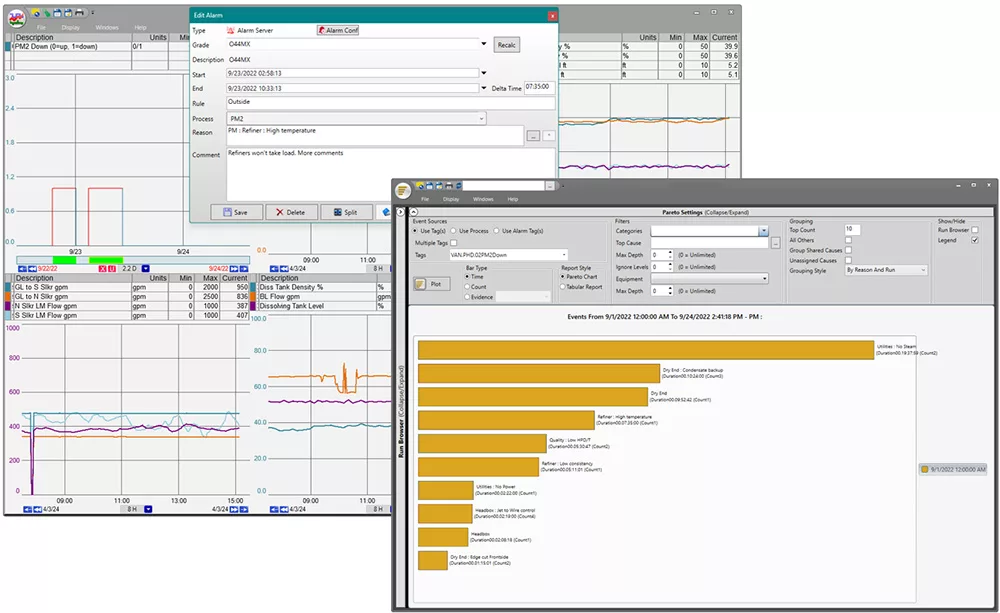
Having all relevant data in one place, like downtime recording and Pareto analysis, facilitates continuous improvement. It allows for swift identification of production inefficiencies and aids in developing targeted strategies to enhance operational performance
Continuous improvement is vital for maintaining high product quality and reliability, which are essential for customer satisfaction and brand loyalty. By integrating OEE software, manufacturers can continuously monitor and refine their processes to ensure consistent adherence to quality standards.
Furthermore, fostering a culture of continuous improvement encourages innovation at all organizational levels. Employees are motivated to propose ideas that can lead to significant enhancements in product design, production methods, and customer engagement. This improves operational efficiency and positions the company as a forward-thinking leader in its industry, adept at navigating the complexities of a rapidly evolving market.
OEE Implementation Process
Implementing OEE from scratch involves several key steps. Here is a general outline of the process, but there is a detailed OEE Guide for more information:
Step 1: Define Objectives
Begin by clearly defining what you aim to achieve with OEE implementation. Set specific goals related to improving equipment efficiency, reducing waste, and enhancing production quality. This step ensures that everyone involved understands the purpose and expected outcomes of the project.
Step 2: Select the Right Tools
Choose the appropriate tools and software for collecting and analyzing OEE data. The selected tools should be capable of integrating with existing systems to ensure smooth data flow and easy accessibility.
Step 3: Identify Key Metrics Collection
Determine how specific metrics that will be collected and calculated to form OEE. Where will the data come from for availability, performance, and quality?
Step 4: Train Your Team
Educate your team about OEE concepts and the chosen tools. Training should cover how to collect data, how to interpret OEE scores, and how to identify areas for improvement. Ensure that all relevant personnel are competent and comfortable with the new system.
Step 5: Data Collection and Analysis
Start collecting data and use the chosen OEE software to analyze it. This step involves tracking over a set period to establish a baseline for current overall equipment efficiency.
Step 6: Review and Interpret Data
Regularly review the collected data and interpret the results. Look for trends, identify bottlenecks, and pinpoint problem areas that are affecting equipment effectiveness.
Step 7: Implement Improvements
Based on the data analysis, implement targeted improvements to address inefficiencies. This may involve adjusting workflows, performing preventive maintenance, or changing equipment settings.
Step 8: Monitor and Refine
Continuously monitor the effects of the implemented changes. Measure improvements in OEE scores and make further adjustments as necessary. This ongoing refinement is crucial to driving sustainable improvements.
Step 9: Standardize and Scale
Once effective strategies have been identified, standardize these across the operation. Consider scaling successful practices to other parts of the facility or to other facilities within the organization to maximize the impact of your OEE improvements.
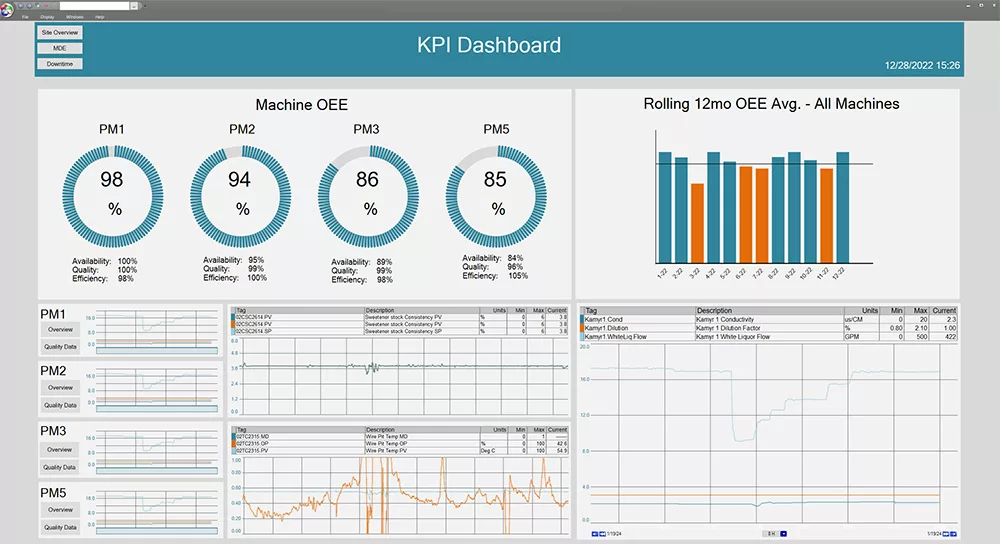
Add OEE across all machines and see them on one display, or create separate displays for each. The flexibility is available.
Following these steps will help ensure a systematic and effective implementation of OEE, leading to improved manufacturing efficiency and productivity.
Boost Productivity with OEE System Real-Time Insights
Implementing OEE is a strategic approach that can significantly enhance the efficiency and productivity of your manufacturing operations. By following the outlined steps for OEE implementation, you can systematically improve equipment effectiveness, reduce waste, and increase the quality of outputs. The process of setting clear objectives, selecting the right tools, training your team, and continuously refining your practices based on data-driven insights will position your operations to achieve optimal performance.
OEE: The Complete Guide
All the resources you need to successfully implement, analyze, & improve overall equipment effectiveness.


